



Dimensions:
The length of Notre Dame is 390 ft.; the
width at the transepts, 144 ft.;
the length of the nave, 225 ft.; and the
width of the nave
(without the aisles), 39 ft.
The height of the vaulting is 102 ft.
Notre Dame de Paris
Timeline
1160
Maurice de Sully proclaims the vision of the cathedral
1163
Cornerstone laid, construction begins
1182
Apse and Choir completed
1196
Death of Maurice de Sully, completion of the Nave
1200
Eudes de Sully begins work on the western facade
1225
Western facade and Rose window completed
1250
Western towers and northern Rose window completed
1250 - 1300
Remaining elements completed
1699
Reconstruction of main altar begun
1741
Stained glass windows removed
1845
Viollet-le-Duc begins major restoration
1864
Restoration completed
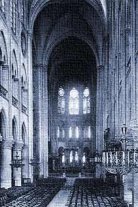
The Nave of
Notre Dame de Paris.
Historic Events
1185
Heraclius calls for the Third Crusade from the Notre Dame
1338 - 1453
The 100 Years War
1431
Henry VI crowned King of France within Notre Dame
1548
Huguenots damage features of cathedral following the council of Trent
1558
The Dauphin Francis weds Mary Stuart at Notre Dame
1572
Henry of Navarre weds Marguerite of Valois, days before the August 24 massacre of the Huguenots
1793
Revolutionaries vandalize Notre Dame, tearing down the gallery of kings and removing all valuables
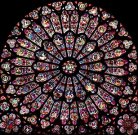 North
Rose Window
North
Rose Window
—Sir. Walter Scott, Life of Napoleon Bonaparte
1804
Napoleon crowned as emperor of France within Notre Dame
1871
The cathedral is set on fire during the commune
1909
The beatification of Joan of Arc held in Notre Dame de Paris
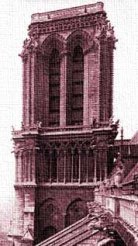 The South Tower
The South Towerin the West.
Visitor
Information
6 place du Parvis de
Notre Dame
75004 Paris
Metro stop: Cité
Telephone: 43.26.07.39
The cathedral is open to the public seven days a week until 6pm. There is no entry fee to the building itself, however a charge of a few euros is required for access to the towers.
Note:
The upper levels are accessible by a narrow, steep stairwell only. Not recommended for the faint of heart or those with an aversion to small spaces.
The Paris Office of Tourism
Official Site
E-mail Newsletter is distributed Free to all interested viewers of Gothic Dreams.
Receive regular updates on: Site additions, Projects, Web events & New learning resources
Stay informed! Request your Free Subscription to:

"We must remind ourselves that these monumental structures, although they remain intensely alive, are merely the skeletons of the cathedrals of medieval times. Compared with what it was when first created, the cathedral, as we see it now, is like a venerable old lady whose noble carriage barely suggests the striking belle she must have been in her youth. We should not only recall the past splendor of the cathedral, most of whose external adornment is now lost, but also attempt to understand what the cathedral was during the progress of its own creation; the role it played at the heart of the city that saw its birth among the people whose stubborn or enthusiastic will alone caused its skyward thrust."
—Zoe Oldenbourg, 'With Stone and Faith'In thinking of Gothic architecture, our thoughts always ascend. For that which embodies Gothic style most is lofty; Rose windows of stained glass, ornately crafted spires, and the guardians of grand cathedrals, the Gargoyles. Each is distinctly Gothic, and all distinctly Notre Dame de Paris.
Many diversified characteristics will help identify a structure as Gothic: ogee archways, ribbed vaults, and the wondrous flying buttresses are a few. Yet, it is always the craft placed high above, which captures our eyes and imaginations most effectively. Since all works of religious art rise beyond mere artistic expression, bearing potent symbolic reference, we must accept that our attention was intended to be focused upwards. Within the span of the passing centuries, the cathedrals of the Middle Ages themselves rise up above other cultural achievements. At the center of these towering legacies resides Notre Dame de Paris, 'Our Lady.'
It does not belittle other cathedrals to refer to Notre Dame de Paris as the 'World Ambassador of Gothic Cathedrals.' History's winding ways have already decreed as much. For many, their first concept of Gothic derives from some reference to this grand structure. It matters not whether we have physically visited Notre Dame, its persona dominates the Gothic landscape.
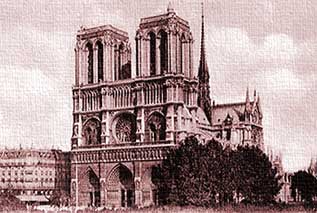 Victor Hugo's famous novel featuring the moving characterization of the hunchback, Quasimodo, has served the notoriety of the cathedral well. Yet, factual history has claimed this aged lady as a prominent figure near the center stage of its own story.
Victor Hugo's famous novel featuring the moving characterization of the hunchback, Quasimodo, has served the notoriety of the cathedral well. Yet, factual history has claimed this aged lady as a prominent figure near the center stage of its own story.
Notre Dame de Paris, more than seven hundred years old, is only the most recent of holy houses to occupy this ancient sacred ground. The Celts held their services on this island in the seine, and atop their sacred groves the Romans built their own temple to Jupiter. In the early years of Christianity, a basilica dedicated to St. Etienne was constructed around 528 by Childebert. A church in the Romanesque manner replaced the basilica, and this stood until 1163 when work began on the structure which stands today.
Constructed in three stages, the cathedral was completed in 1250. This period witnessed Paris coming into its own force as a center of political power and commerce. No expense was spared in creating a church that would reflect the capital's newly won prestige. These were the 'development' years of early Gothic architecture, it was essential that Paris should contain an impressive cathedral featuring innovations to surpass such smaller towns as Sens and Noyon. An advantage which Paris possessed over other sites, was that the construction efforts were supported and encouraged by the the king, Louis VII.
King Louis VII must be considered among the handful of influential figures during the rise of the Gothic style in France. It is certain that without the influence of the King's support, Abbot Suger would never have realized his vision of reconstructing Saint-Denis. At the Abby of Saint-Denis, the sparks of inspiration were kindled which would ignite the fires of the cathedral building age. Some twenty years later, the king lent this same support to the construction of the new cathedral of Paris. Louis supported the work with generous and gracious contributions. Clearly he had motivations for strengthening France's eminence as the stronghold of Christendom, but his piety must be considered authentic in the perspective of history.
"Gothic architecture had a magnificent opportunity of development in the construction of the great cathedrals, which, in France, were all built at the end of the twelfth and beginning of the thirteenth centuries.
These were civil as well as ecclesiastical buildings; in fact, the distinction between the two provinces was a thing unknown at the time, and is wholly a modern idea, which we never probably would have had except for the differences in religious belief which arose among us at the Reformation. The state is merely the community acting in combination for those purposes in which combined action is more convenient than individual. With us these are now almost confined to justice, police, war, and possibly education. But when religious belief was uniform, as in the Middle Ages, state action included religion. The bishops and abbots were feudal barons, with civil jurisdiction; and, on the other hand, all state action had some religious character and sanction. The cathedrals were the great meeting-places of the city, used for secular purposes, such as the administration of justice, and even for histrionic performances (which, again, were religious in character), as well as for mass."
—John J. Stevenson, Gothic Architecture;Harper's New Monthly Magazine, 1876
The early twelfth century was a time of great activity and excitement within Europe. The Church was in a state of great transformation due to the reforms of Pope Gregory VII. The monasteries as the primary avenue of distribution for the new order, directed by Bernard of Clairvaux, were centers of learning and creativity. The First Crusade was underway and the holy city of Jerusalem had been taken from the very heart of Islam.
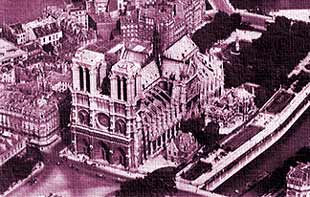 Within the swirl of these influences arose the new abbey of Saint-Denis. Visiting bishops took home with them inspirations for new cathedrals of their own. In the following decades these visions arose as a wondrous reality across France.
Within the swirl of these influences arose the new abbey of Saint-Denis. Visiting bishops took home with them inspirations for new cathedrals of their own. In the following decades these visions arose as a wondrous reality across France.
Witnessing the early development of Saint-Denis was a subdeacon of Paris, Maurice de Sully. In 1159 he became archdeacon, with building ambitions of his own, and scantly one year later was elected Bishop. Almost immediately, Maurice went to work organizing resources for the commencement of the cathedral's construction. Funds were raised, crews were gathered and the site was cleared of surrounding buildings. In just three years from his consecration, the cornerstone was laid and full production began.
Throughout northern France, at this time, churches and cathedrals were rising up in several towns. It was not hard to secure skilled crews from professional guilds for the site in Paris. Organized teams of workers would migrate from town to town according to the stage of construction which required their expertise.
As for the raw material for the building itself, this too was readily available from local sources. The region surrounding Paris was rich in a variety of quality stone. The majority of material used in Notre Dame was taken from nearby quarries. Still, transporting stone was costly, even over a short distance. To economize weight, much of the cutting and rough preparation of the blocks was accomplished at the quarry sites. Final dressing of the stone elements was executed within the masons' lodge, adjourning the cathedral.
We do not know the name of the first master mason of Notre Dame de Paris. The title of Architect, did not come into use until centuries later. From the quality and consistency of the work during this early period, we can accept that the bishop had found someone quite capable of overseeing the realization of his intention. To his own credit, Maurice proved to be a competent overseer of the works. The books remained balanced through the production, maintaining a steady and methodical level of growth. The choir, apse and chancel were completed first so that there would be a place for services though the later stages of construction.
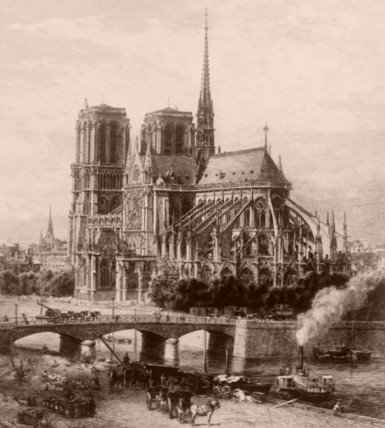 Nineteenth Century Engraving of Notre Dame from Southeast.
Nineteenth Century Engraving of Notre Dame from Southeast.The subsequent phases of the works were to realize the grand scale of the bishop's original vision. The aims of Paris would push many of the limits of the new style beyond anything yet attempted. The breadth of the vaults and their height would surpass all previous achievements. An important innovation at Paris was the combination of triangular ribs with subtle transverse arches. The result of this technique was to open wide the interior of the cathedral without the visual interruption of supporting elements. This achievement is impressive to view even by contemporary perspectives.
By the time of Maurice's death in 1196, the nave had been completed and the cathedral was well on the way of rising to its full, intended glory. Within the following fifty years the remaining elements would be finished without major interruption. What extended the date of the completed cathedral was the intervention of Maurice's successor Bishop Eudes de Sully. (The similarity of the name indicates that the two bishops were born in the same town, there was no relation between them.)
Unlike his predecessor, Eudes was a wealthy noble, and contributed a good deal of funds to the cathedral works. It was within the bishop's means to enlarge on the original designs, and he did so. This was most evident in the west facade which took twenty five years to complete up to the level of the rose window. It would take yet another twenty five years to finish the twin towers.
The remaining elements of the cathedral were accomplished over the following five decades; the north rose, the transept facades and the chapels of the ambulatory. The expansion to the west facade excluded, the finished cathedral was true to its original design, it would remain so until the end of the seventeenth century.
 Under the reign of Louis XIV the cathedral's original form suffered greatly. Four hundred years had passed since Notre Dame was completed. Naturally styles and tastes had changed a great deal during the centuries. The manner known now as 'Gothic' in a negative sense, was perceived as crude and barbaric at best. Within an effort to adapt the cathedral to Baroque standards, stained glass was smashed out, tombs were destroyed and a new high altar was constructed. As a finish, after fifteen years of reconstruction, the interior of the cathedral was completely whitewashed.
Under the reign of Louis XIV the cathedral's original form suffered greatly. Four hundred years had passed since Notre Dame was completed. Naturally styles and tastes had changed a great deal during the centuries. The manner known now as 'Gothic' in a negative sense, was perceived as crude and barbaric at best. Within an effort to adapt the cathedral to Baroque standards, stained glass was smashed out, tombs were destroyed and a new high altar was constructed. As a finish, after fifteen years of reconstruction, the interior of the cathedral was completely whitewashed.
The succeeding centuries were equally unkind to the Lady of Paris. During the Revolution, a great deal of the features of the cathedral were stolen defaced. Churches and cathedral throughout France were rededicated to the cult of Reason. Just prior to the Revolution, countless ornaments, sculptures and gargoyles were removed because contemporary architects found them tasteless. This great destruction paled by comparison to what occurred during the height of the Revolution. After all the wealth had been stripped from away, all traces of religion and monarchy were ordered removed. Perhaps the greatest destruction was the pulling down and smashing of the gallery of kings. In an act of ringing of primitive tribalism, the heads of the statues were distributed like war trophies amongst the communes of Paris. The broken bodies lay in pieces for before the shamed lady for three years before they were removed to the city coal yards. For the following years the cathedral was utilized primarily for secular gatherings and commemorations.
It would not be until the full passion of the Romantic movement swept across France, in the mid nineteenth century, that a sincere restoration was undertaken. The hearts of the Romantic era prized works of the past which were felt as distant reminders of a more meaningful life than could be apprehended through modern lifestyles. One of the movements young stars is still very much associated with the grand lady of Paris, though many today are not aware of how significant a role he played in its rescue.
 The Gallery of Kings upon the West facade.
The Gallery of Kings upon the West facade.
Victor Hugo was just twenty eight years old when he wrote his novel: Notre Dame de Paris. (Later known as The Hunchback of Notre Dame.) Set in the medieval period, it tells the story of the deformed Quasimodo, ward of the cathedral, and his ill-fated love for the beautiful Gypsy dancer, Esmeralda. Published in 1831, the novel held up architecture in a noble light. Through the eyes of this young, impassioned writer, the cathedrals of the middle ages were 'books in stone,' works to be treasured and cared for. He showed no restraint for attacking the indignities that had been heaped upon Notre Dame over the centuries. What he could not have foreseen, was the fertility of the popular mind, at this time, for such a message. The novel achieved widespread acceptance, sparking a keen interest in the fate of the cathedral.
Among the audience captured by Hugo's tale, was a young man who had just entered school for the study of architecture. Eugène Emmanuel Viollet-le-Duc, a talented, young Parisian, was to become the commander of this growing crusade for restoring and preserving the wonders of an elder Paris.
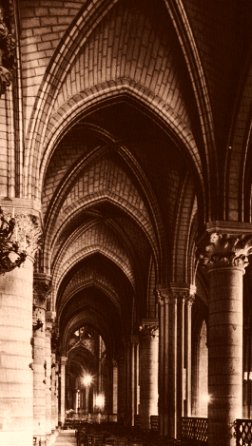 In particular, Notre Dame, itself, would become the centerpiece of his life's work. Viollet-le-Duc was appointed to head a new commission dedicated to the preservation of historical monuments. His knowledge of medieval building techniques allowed for a reconstruction true as possible to original intentions.
In particular, Notre Dame, itself, would become the centerpiece of his life's work. Viollet-le-Duc was appointed to head a new commission dedicated to the preservation of historical monuments. His knowledge of medieval building techniques allowed for a reconstruction true as possible to original intentions.
In sharp contrast to the accepted views of the preceding centuries, Viollet-le-Duc, valued the views of the Gothic era. What he saw in the works of the middle ages was clear evidence of authentic intent. Exemplified in Notre Dame, a pure style, whose utility did not sacrifice its visual significance, could still be recognized. At the dawn of the Industrial age, such honest, traditional expressions were valued as evidence of stability within prevailing transitions. In the 23 years which the restoration occupied, commencing in 1845, Viollet-le-Duc never lacked for public or financial support, even during periods of turmoil. Under his meticulous guidance, much of the early splendor of the cathedral was reborn. Once more, the gallery of kings looked proudly unto the crowds below, gargoyles settled into their lofty places, the damaged elements throughout Notre Dame were carefully restored and the whitewash paint was scoured away.
Little else has changed since the completion of Viollet-le-Duc's work, little has needed to. The twentieth century seemed intent on compensating the aged lady for the neglect and abuse of earlier times. In 1909 the cathedral hosted the beatification of Joan of Arc, an event which moved spirit of the nation itself. As Paris became the artistic center of Europe, so Notre Dame became the heart of Paris. Slightly damaged by shelling in 1914, the cathedral survived both World wars virtually intact. Today there is an extensive program of maintenance being undertaken, expected to reach completion in 2001. Under the managed care of the National Trust for Historic Monuments, it is assured that the Grand Lady of Paris shall safely bear her legacies into the centuries of the new millennium.
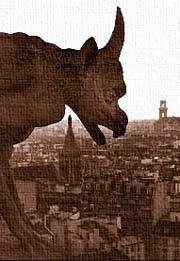
'And the cathedral was not only company for him, it was the universe; nay, more, it was Nature itself. He never dreamed that there were other hedgerows than the stained-glass windows in perpetual bloom; other shade than that of the stone foliage always budding, loaded with birds in the thickets of Saxon capitals; other mountains than the colossal towers of the church; or other oceans than Paris roaring at their feet.'
—Victor Hugo, Notre Dame de Paris, 1831Photographic Features of Notre Dame de Paris
Bibliography
Eugène Viollet-le-Duc, Paris (1858-68)
Yves Bottineau, Rand McNally and Co. (1967)
Georges Duby, London (1981)
J. Bony, Berkeley (1983)
Development & Production Credits
Primary Text : Rhey Cedron — Theme Editor : Nicole MarchStructural Design & Project Direction : Rhey Cedron
Art Direction : Rhey Cedron — Art Production : Mark Nelson & Ash' Murti
Artistic Consultant : Thierry Alberto
Principal Photography : Rhey Cedron
Art Research : Malcolm Hurrell — Support Research : Walter McCrae
(Life) Support Production : Henry Craig, Joan Flandrin, Clara Kelly and
a Patient Legion of Friends, Family & Angels
Learn more about the Earthlore story, upcoming web features and future
cultural projects. Ask to receive your free newsletter
Your questions or comments are always welcome!
Gothic E-mail
Individual use of enclosed material is encouraged for the purposes of education and enjoyment.
The republication of textual or graphic content, without license, is an infringement of Copyright laws.